All profits to

Archive Home Page
Previous Exhibition Following Exhibition
St. Margaret's Hall, Coniston Road, Hatherley, Cheltenham, GL51 3NU
All profits to |  |
Descriptions are based on material supplied by the layout owners
Bettws Road Bettws Road is a fictitious location based in Wales around the 1930/40 era. The village has a terminus station with its own goods yard and coal staithes. Railcars serve the station while express passenger trains use the main line along with the odd freight train. | 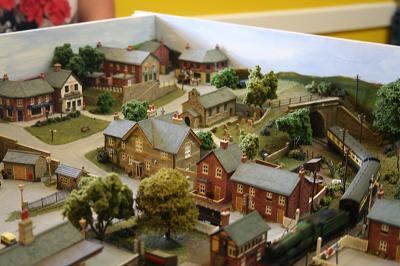 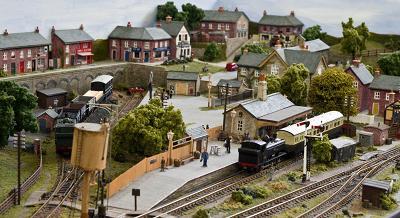 | |
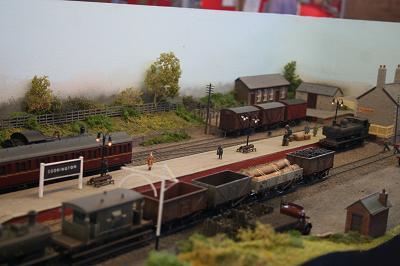 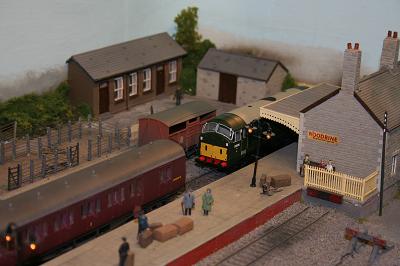 |
Codrington has been produced by members of the Sodbury Vale Model Railway Club. The layout depicts a typical British branch line terminus in the 1950s or early 1960s, a period of great transition as road transport took over from railways and steam gave way to diesel traction. The choice of buildings, scenic details, colours, plus locomotives and rolling stock re?ects a setting not too far from the Bristol area. In most cases, the rolling stock has been weathered to replicate the condition of the period. The goal was to produce a railway in its landscape despite the relatively small size of the layout; only 12 feet by 2 feet. The main aim of the layout was to show what could be achieved with modern readily available off the shelf 00 gauge products and materials. To this end it uses buildings from Hornby and Bachmann plus Peco code 75 track giving a ?ner appearance. Points are operated by Fulgarex slow action motors and the signals are from the new Dapol range. The ready to run locomotives are controlled using Digital Command Control (DCC), a relatively new innovation in model railways. This provides excellent running through precise motor control and greatly simplifies the amount of layout wiring. Reliable hands off shunting of rolling stock is achieved by using Sprat and Winkle auto couplings which are a simple to fit modification to the off the shelf stock. | |
Dent Dent station is on the Settle to Carlisle line of the Midland Railway and serves the villages of Cowgill and Dent. Completed in 1877 the line is renowned for the rugged Moorland, its tunnels, viaducts, amazing scenery and snow, the stone station building itself is famous for being the highest on the English railway network at 1,150 feet. The layout is 00 gauge built to traditional methods using Peco ?ne scale track. It was inspired by the work of David Jenkinson and built to provide a circular layout that I could sit back and watch trains run round. The scenery attempts to capture the bleakness of Blea Moor, the landscape with extensive stone built walls and snow fences. The track gang you can see working muffled up in overcoats against the cold and the lack of passengers reflect the distance of the station from any local housing. Cowgill village is half a mile away while Dent itself is nearly 5 miles further to the west. The layout runs with LMS motive power on one day and British Railways steam the other, rolling stock re?ects this. |  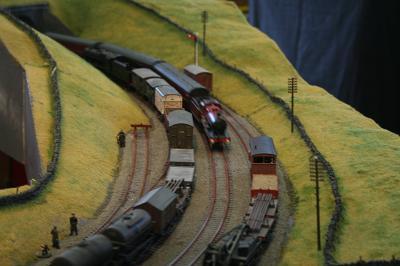 | |
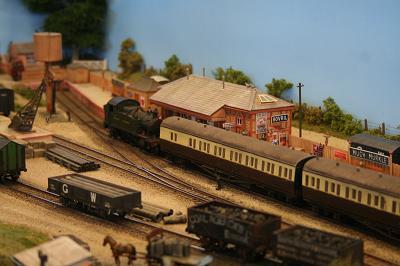 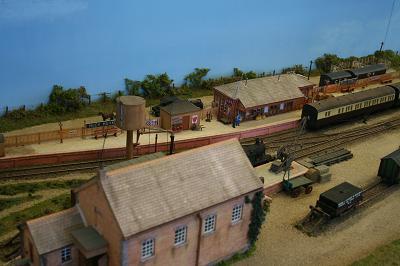 |
Much Murkle is set in a fictitious 1930's Herefordshire community served by the Great Western Railway, it had a population of 1,452 people according to the 1931 census. The town is served by a single track branch from the equally ?ctitious junction at Newent on the Gloucester to Hereford Line. The branch is just 8 miles long, with one intermediate station at the village of Kempstone, a small halt serving Sollers Hall and finally Much Murkle itself. There is a rail served quarry located approximately 1 mile outside of Much Murkle. All trains departing the quarry have to reverse at the terminus station before heading back to the main line. The quarry has no run round facility, this often leads to more interesting stock movements. The quarry is not the only significant industry using the line. Rancoutt Cider use the branch to distribute their fine Cider and Perry to the outside world, vans from all the big four rail companies can be found in the sidings. | |
Newton East Newton East as the name implies is a station on the outskirts of the town of Newton. Originally built by a pre-grouping company, the line has survived the Beeching cuts and forms a busy avoiding line. The goods yard is also busy as the old factory buildings have been taken over by a mail order company and so wagons come and go bringing and taking away products. In reality the layout is purely fictitious and has been designed and built to entertain the viewing public and provide interest for the operators. The layout has no geographical location but is set during the period of 1955-65 and shows rolling stock (predominantly diesels) that would have been seen on British Railways during that period. The layout permits rolling stock from the Southern/Western and Midland/Eastern/North Eastern regions to be run together. The track work is ‘SMP’ with hand built pointwork using PCB sleepers and nickel-silver bull-head rail and operated with ‘Peco’ motors. Electrically the layout can be operated by 1 or 2 operators with their own controllers. The buildings are mainly from card or plastic kits either as designed or modified to suit. The rolling stock is a mixture of proprietary and kit built, all vehicles would have been seen on BR in the 1955-65 period although not necessarily together. We have concentrated on using diesels but occasionally a steam locomotive may appear | 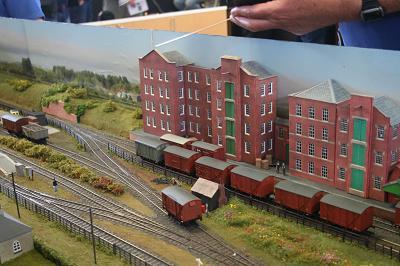 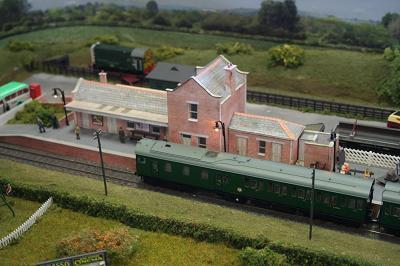 | |
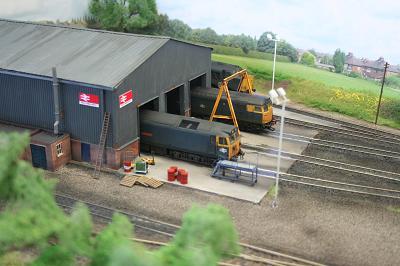 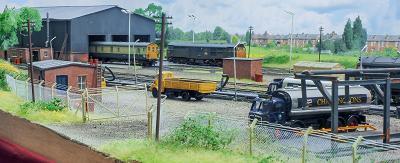 |
Oakley Green is an oil storage depot, the layout also includes a diesel locomotive servicing area and refuelling point, plus a small parcels loading area in the vicinity to add extra interest and shunting possibilities. The scene is based in the mid 1970’s and located in the rural home counties to the west of London. Ideas were taken from Mickeldever Station, Eastleigh Depot and other selected parts of the Southern Region. The oil depot comprise of six large storage tanks, with piping on gantry work connecting to the rail tanker loading areas and fed underground for the road loading complex. The facility modelled is also complete with a plant room and general service areas. Next door to the oil depot is the parcel handling area which is used to feed the local road network. To the far left of the layout is the diesel service depot comprising a large workshop, refuelling point and diesel loading shunt. The majority of the buildings are scratch built, with some kits used for the many detailed items. The track is Peco code 75 and is fully DCC controlled using a NCE PowerCab, complete with fully powered points and working signals. The rolling stock comprises a good selection of period BR blue locomotives all with DCC sound and lights, with the odd surprise. Completing the display is a nice selection of oil and parcels wagons. | |
Thomas We would like to thank Trevor Hallam for looking after the Thomas Layout for many years at our exhibitions and also for refurbishing it at his expense. Unfortunately because of ill health Trevor is no longer able to continue so it was decided to offer Thomas free of charge to Hucclecote Railway Modellers on condition they bring it to all of our future exhibitions. This is the model railway where Children can become Engine Drivers on the Island of Sodor and has of course been inspired by the Reverend Audrey books. Our Thomas and Friends layout has been built for ten years now and in that time we hope it has encouraged many new railway enthusiasts to build a train set of their own. Originally it was intended as a space filler at shows so needed to be small, easy to transport and have a simple track plan, easy for small children to operate. After its first appearance it was clear this model railway would have to be included at all our exhibitions. It incorporates a tunnel, station, level crossing together with locomotive and goods facilities. Train drivers should look out for many of the popular characters; Henry, Percy, Toby, Cranky, the Troublesome Trucks, not forgetting the Sir Topham Hatt better known as the Fat Controller. The famous anthropomorphised rolling stock is mostly from the Thomas range and we are sure most of the adults and all the kids will love it. Happy Driving, but please observe the track speed limits. | 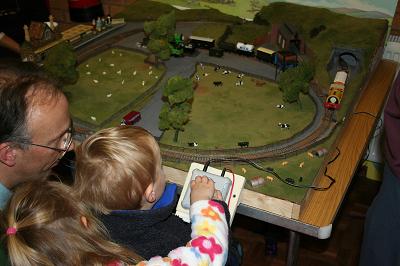 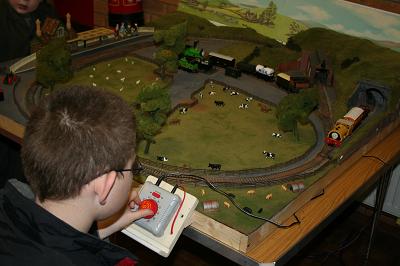 | |
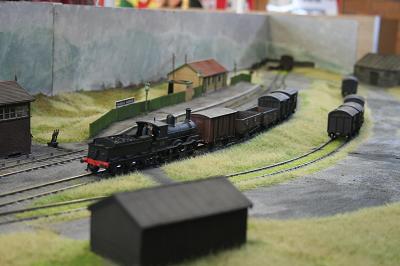 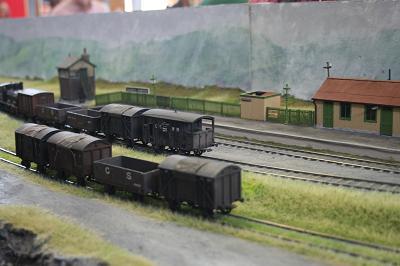 |
The layout is set in the South of Ireland, County Kerry to be exact circa 1935 on the Great Southern Railway. The line to the settlement of Valencia left the Great Southern and Western Railway line between Killarney and Tralee at Farranfore and was built in a number of stages between 1885 and 1893. Valencia's main claim to fame was being the western most railhead in Europe and the point where the North Atlantic telegraph cable entered the Ocean, hence the warning triangle that can be see by the building. The prototype line itself was sadly closed in 1960. The model is built to 4mm scale and to the correct gauge of 5 foot 3 inches or 21mm track width. The stock is mainly kit built from various sources. Any questions or observations on Irish lines and modelling are gratefully re- ceived | |
Worcester Road Diesel Depot Worcester Road Diesel Depot is Gauge 1 1/32nd scale. It is a straightforward shed, 10 feet by 2 feet, operated from the front. The scenic/diorama engine shed board is 6 feet long and the fiddle yard board is 4 feet long. With the side wall removed, giving a wide screen pillar box aperture for viewing into the shed, the viewer is forced to get down low and appreciate the vista in a more realistic view from ground floor. If you get close enough to the model, the viewer becomes part of it and it is possible to belileve you are in the shed with the locomotives, especially if the outer edges of the strucure are beyond the viewer's peripheral vision. Everything within the locomotive servicing shed has been scratch-built, apart from the barrels,lathes and other tools which have come from 1/35th military modelling kits. Worcester Road is located in Hereford and acts as a small service point able to supply fuel/water/oil and other daily servicing requirements for the diesels that arrive on the London trains, predominantly Warship class locomotives. It is also used occasionally to service rolling stock when the carriage and wagon repair shops are full. It must be emphasised that the only authority to enter a diesel depot issued is in the form of a permit from the responsible office. So it is with thanks to Mike Walker (show organiser) who has allowed you a permit to access Worcester Road. Please take time to enjoy Worcester Road Diesel Depot as it has taken 10 years to build. Steve Harrod is a member of Cheltenham Diesel Hydraulic Modellers Group. | 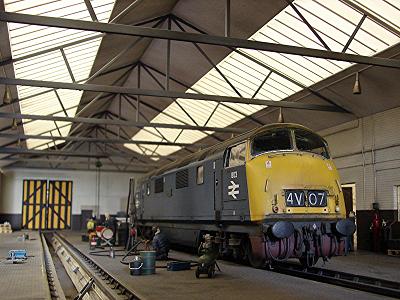 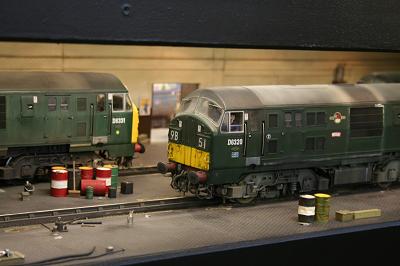 | |
| Displays | ||
South Downs bus rally & vintage show | Mini scenes | |
Universal Works in the Gathering Storm WEBSITE | The Town Scene | |
| Modelling Demonstrations | ||
| Andi Dell | Mark Begley | |
| Richard Bucknall | Trevor Hale | |
| Trade | ||
| Castle Trains WEBSITE | Cheltenham Model Centre WEBSITE | |
| RCSW (Pre-owned) Models, Clive Reid | Rly books, timetables, photos, Stewart Blencowe WEBSITE | |